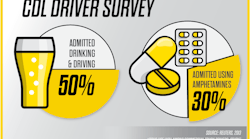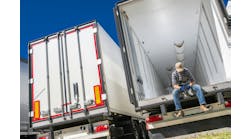Guest Blog: Educate drivers on the Drug and Alcohol Clearinghouse
There are many ways the Drug and Alcohol Clearinghouse (DAC) will impact your hiring process. Among them: it’s critical to provide training and education to your drivers, potential hires, and recruiting managers about it. Since the DAC will provide a reason to not hire a person or to fire an existing employee, using the program wrong or misrepresenting how it will be used could lead to lawsuits.
The DAC is a big topic, so if you’re familiar with it, you might skip to the bottom of this article. That’s where we talk about how the DAC fits into your hiring process and the legal exposure. ITI’s training course on the DAC is included with the PRO-TREAD online truck driver training core library, and our Drug and Alcohol Awareness course and Driver Disqualifications courses cover the more general rules around regulated drugs and alcohol use.
In the meantime, let’s start at the beginning.
What does the clearinghouse aim to solve?
A multi year study of truck drivers and their working conditions found that the “overall use of mind-altering substance was high,” typically due to the long hours and desolate nature of the job.
Half of the drivers interviewed in the 2013 study admitted to drinking, with 12.5 percent of driver drug tests revealing alcohol in the driver’s system. Thirty percent of drivers confessed to taking amphetamines to help them stay alert. In recent years, we are seeing marijuana being legalized state-by-state.
The link between drug and alcohol use and unsafe driving is clear: It’s a lethal mix that can have disastrous results for the driver and the motoring public.
In response to drug use trends among truck drivers and the fact many carriers experience driver churn, the Federal Motor Carrier Safety Administration (FMCSA) determined the need for a clearinghouse to track drivers’ drug test results. The fundamental problem being addressed is that when drivers fail or refuse one of these tests, they’ve been easily able to jump to another carrier before those results were known.
What is the Drug and Alcohol Clearinghouse?
At a high level, the Drug and Alcohol Clearinghouse — basically just a database — provides visibility into those results to hiring carriers.
Importantly, it’s also a central database for medical review officers and substance abuse professionals to report on the progress of addiction recovery and treatment programs. This allows drivers with violations to re-start their employment.
By mandating reporting of the types of results and refusals that must be reported, the Drug and Alcohol Clearinghouse helps the FMCSA and motor carriers better identify commercial drivers who are prohibited from operating commercial vehicles due to violations and refusals.
The clearinghouse will interface with the Commercial Driver’s License Information System (CDLIS) and track drug and alcohol violations for domestic and foreign drivers, regardless of how many times the driver changes jobs or applies for a CDL in a different state. This prevents drivers from getting hired by a carrier after committing a drug or alcohol violation while working for another employer.
How does the clearinghouse work?
Carriers and the firms they hire to handle drug, alcohol, and medical information are required to report information around drug and alcohol tests, as well as treatment programs.
And all of those groups must also disclose to drivers and CDL students that test results, refusals, and treatment information will be reported to the clearinghouse.
Who Must Report?
Prospective or Current Employer of CDL Driver or Third Party Administrator (on behalf of Current Employer of CDL Driver)
- An alcohol confirmation test with a concentration of 0.04 or higher
- Refusal to test (alcohol) as specified in 49 CFR 40.261
- Refusal to test (drug) not requiring a determination by the MRO as specified in 49 CFR 40.191
- Actual knowledge, as defined in 49 CFR 382.107, that a driver has used alcohol on duty, used alcohol within four hours of coming on duty, used alcohol prior to post-accident testing, or has used a controlled substance
- Negative return-to-duty test results (drug and alcohol testing, as applicable)
- Completion of follow-up testing
MRO (Medical Review Officer)
- Verified positive, adulterated, or substituted drug test result
- Refusal to test (drug) requiring a determination by the MRO as specified in 49 CFR 40.191
SAP (Substance Abuse Program)
- Identification of driver and date the initial assessment was initiated
- Successful completion of treatment and/ or education and the determination of eligibility for return-to-duty testing
What is the clearinghouse process?
- The employer makes an electronic request for information
- The driver is notified and their consent is requested
- FMCSA receives electronic consent from the driver
- If records exist, they are released to the employer
Availability of records
Records of violations remain in the clearinghouse until all the following provisions are met and reported to the database:
- The driver completes a SAP evaluation and recommended education/treatment process
- The driver receives a negative return-to-duty test
- The driver successfully completes all follow-up tests
- Five years have passed from the day the violation is submitted.
How will employers use the clearinghouse?
Employers must register with the clearinghouse and perform queries on current employees annually. Registration is good for five years unless it is revoked, cancelled or remains unused for two years.
When hiring a CDL driver, carriers must search the clearinghouse to see if the driver has any drug or alcohol violations.
Employers will also have to submit detailed documentation of “actual knowledge” violations. Employers must also ensure that a driver under these circumstances doesn’t perform any safety-sensitive functions until the driver has completed the return-to-duty process.
When does the clearinghouse open?
The clearinghouse is scheduled to start on January 6, 2020 and will only contain violations that occur on or after this date. Any violations that occur prior to launch date will not be included in the clearinghouse.
Registration for all parties — employers, drivers, third-party administrators, substance abuse programs — is open now at clearinghouse.fmcsa.dot.gov.
Although the clearinghouse will not be live until January 6, 2020, carriers can take steps now by educating fleet leaders, managers, recruiters, DOT compliance staff and drivers about the clearinghouse. Carriers should also work with their 3rd party administrators who conduct drug and alcohol testing to make sure everyone is on board with the purpose and the process involved with accessing and entering data into the clearinghouse.
Why is educating drivers and employees critical?
As an employer, it’s critical you start educating drivers and prospective drivers now. To do a query on a driver, you must get the driver’s consent. The driver needs to register with the DAC so they can provide consent for the queries, and to know what they’re consenting to.
Why is this so important? Consider your hiring process and the number of lawsuits that come out of it. At some point before you extend a contingent job offer, you must get the driver’s consent. And since the DAC is so new and because the DAC could very quickly disqualify your candidate, your corporate counsel is going to insist on educating the prospect. You don’t have to be terribly cynical to believe there are attorneys on the prowl who would love to sue a fleet for retracting a job offer over this.
Information provided by Instructional Technologies



